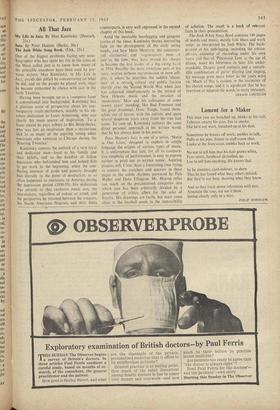All That Jazz
The Josh White Song Book. (Elek, 25s.) ONE of the biggest problems facing any auto- biographer who has spent his life in the arms of the Muse called jazz is to know how many of the printable anecdotes have been used by pre- vious writers. Max Kaminsky, in My Life in Jazz, avoids this pitfall by concentrating on what he did, and on the people he played with, since he became embroiled by choice with jazz in the early Twenties.
Having been brought up as a trumpeter from a conventional jazz background, Kaminsky has a glorious sense of perspective about his con- temporary rivals/performers, notably in his ab- solute dedication to Louis Armstrong, who was clearly his main source of inspiration. To a lesser extent he pays tribute to Six Beiderbecke, Who was less an inspiration than a mysterious idol to so many of the aspiring young white musicians who ventured to Chicago during the 'Roaring Twenties.'
Kaminsky conveys the outlook of a very loyal and dedicated man—loyal to his family and their beliefs, and to the handful of fellow musicians who befriended him and helped him to get work in the beginning, when the con- flicting interests of pride and poverty brought him literally to the point of destitution, as so often happened to musicians in America during the depression period (1930-35). His dedication Was entirely to that exclusive music sect, the Jazz-makers, regardless of colour or creed, and the perspective he retained between the crevors, the North American Negroes, and their white counterparts, is very well expressed in the second chapter of this book.
Aniid the inevitable bootlegging and gangster stories of the times, Kaminsky throws interesting light on the development of the early swing bands, and how Kezz Mezzrow, the controver- sial clarinettist and 'organisation man ot jazz at the time, may ha v.: missed hi. :.hance to become the lirst leadei it a big .wing (mad in 1934. Possibly the mosi trenchant part ot his story, written without recrimination or even self- pity, is where he describes the sudden 'about- face' of a certain, critical and public faction shortly after the Second World War when jazz was subjected simultaneously to the revival of New Orleans music and the invasion of 'modernists.' Max and his colleagues of some twenty years' standing, like Bud Freeman and the great drummer, Dave Tough, found them- selves out Of favour with the cultists, and spent several desperate years away from the true jazz scene. To sum up, Kaminsky conveys the same direct personal approach in his written words that he has always done in his music:
Peter Heaton's Jazz is one of a series; 'Music in Our Lives,' 'designed to explain in simple language the origins of various types of music. It is unfortunate that jazz, for all its compara- tive simplicity of performance, is easy to express neither in print nor in written music. Aspiring pianists will, I fear, have a frustrating time trying to convert the crotchets and quavers in these pages to the subtle rhythms purveyed by Fats Waller and Duke Ellington. Mr. Heaton ,relies too much on the preconceived categories into which jazz has been arbitrarily divided by a generation of critics, albeit for the sake of brevity. His drawings are facile, but must come close to the football pool, in the impossibility of solution. The result is a book of relevant facts in their presentation.
The Josh White Song Book contains 146 pages of words and music, mostly folk blues and work songs. as interpreted by Josh White. The back- ground of his upbringing, including the schizo- phrenic existence of recording under his own name and that of 'Pinewood Tom' at the age or fifteen, make his bitterness in later life under- standable. Despite good contacts and a remark- able combination of guitar playing and singing, his message grew more bitter as the years wore on. Much of this is evident in the testimony of his chosen songs, and it is significant that he has rewritten or adapted the words in many instances.
GERALD LASCELLE§

































 Previous page
Previous page